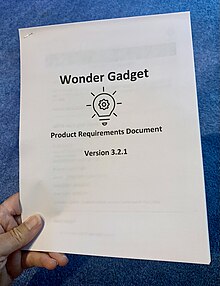| Marketing |
|---|
A product requirements document (PRD) is a document containing all the requirements for a certain product. It is written to allow people to understand what a product should do. A PRD should, however, generally avoid anticipating or defining how the product will do it in order to later allow interface designers and engineers to use their expertise to provide the optimal solution to the requirements.[citation needed]

PRDs are most frequently written for software products, but they can be used for any type of product and also for services. Typically, a PRD is created from a user's point-of-view by a user/client or a company's marketing department (in the latter case it may also be called a Marketing Requirements Document (MRD)). The requirements are then analyzed by a (potential) maker/supplier from a more technical point of view, broken down and detailed in a Functional Specification (sometimes also called Technical Requirements Document).
Typical components of a product requirements document (PRD) are:[citation needed]
Not all PRDs have all of these components. In particular, PRDs for other types of products (manufactured goods, etc.) will eliminate the software-specific elements from the list above, and may add in additional elements that pertain to their domain, e.g. manufacturing requirements.